2011 HONDA ODYSSEY child seat
[x] Cancel search: child seatPage 56 of 722

Each third row seat has a tether
anchorage point behind the seat-
back.Tighten the strap according to the
seat maker’s instructions. Attach the tether strap hook to the
anchor, making sure the tether
strap is not twisted.
You can also remove the rear head
restraints (see page ). The removedheadrestraintsshouldbe
secured in the cargo area so they will
not be thrown while you are driving.
Make sure to replace the head
restraints when the child seats are
not in use.
Af ter properly securing the child
seat (see pages and ), lif t the
head restraint, then route the
tether strap over the seat-back and
through the head restraint legs.
Tighten the strap according to the
seat maker’s instructions.
If the tether strap is too long and
cannot be tightened f irmly, f ind a
route where the strap can be
tightened securely. 3.
3.
1.
2.
5150
187T hird Row Inst allat ion
Installing a Child Seat
Driver and Passenger Saf ety
53
TETHER ANCHOR POINTS ANCHORTETHER STRAP HOOK
ANCHOR
Center Position (except LX models)
TETHER STRAP HOOK
10/07/17 09:41:21 31TK8600_058
2011 Odyssey
Page 57 of 722
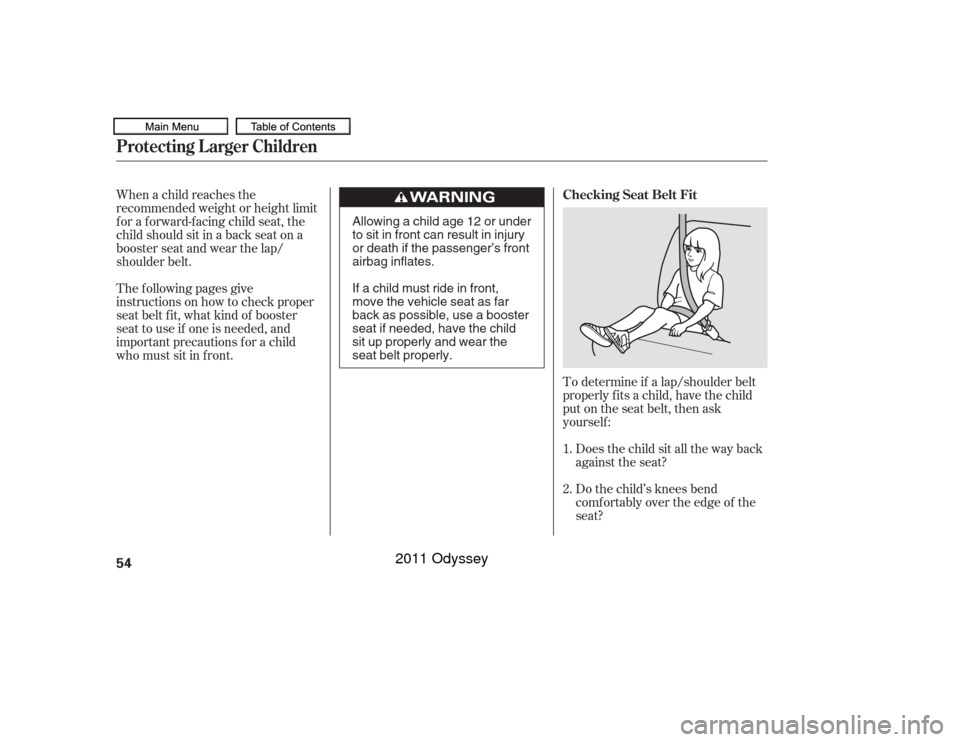
To determine if a lap/shoulder belt
properly f its a child, have the child
put on the seat belt, then ask
yourself :Does the child sit all the way back
against the seat?
Do the child’s knees bend
comf ortably over the edge of the
seat?
When a child reaches the
recommended weight or height limit
for a forward-facing child seat, the
child should sit in a back seat on a
booster seat and wear the lap/
shoulder belt.
The f ollowing pages give
instructions on how to check proper
seat belt f it, what kind of booster
seat to use if one is needed, and
important precautions f or a child
who must sit in f ront.
1.
2. Checking Seat Belt Fit
Protecting L arger Children54
Allowing a child age 12 or under
to sit in front can result in injury
or death if the passenger’s front
airbag inflates.
If a child must ride in front,
move the vehicle seat as far
back as possible, use a booster
seat if needed, have the child
sit up properly and wear the
seat belt properly.
10/07/17 09:41:29 31TK8600_059
2011 Odyssey
Page 58 of 722
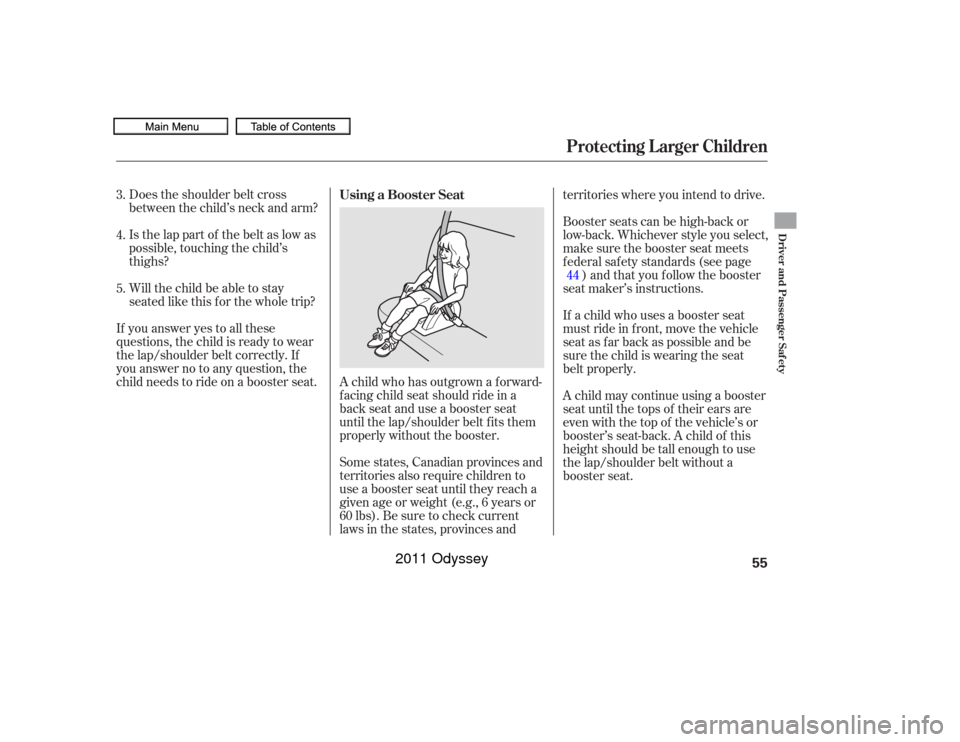
A child who has outgrown a forward-
f acing child seat should ride in a
back seat and use a booster seat
until the lap/shoulder belt f its them
properly without the booster.
Does the shoulder belt cross
between the child’s neck and arm?
Is the lap part of the belt as low as
possible, touching the child’s
thighs?
Will the child be able to stay
seated like this f or the whole trip?
If you answer yes to all these
questions, the child is ready to wear
the lap/shoulder belt correctly. If
you answer no to any question, the
child needs to ride on a booster seat.
Some states, Canadian provinces and
territories also require children to
use a booster seat until they reach a
given age or weight (e.g., 6 years or
60 lbs). Be sure to check current
laws in the states, provinces andterritories where you intend to drive.
Booster seats can be high-back or
low-back. Whichever style you select,
make sure the booster seat meets
f ederal saf ety standards (see page
) and that you f ollow the booster
seat maker’s instructions.
If a child who uses a booster seat
must ride in f ront, move the vehicle
seat as far back as possible and be
sure the child is wearing the seat
belt properly.
A child may continue using a booster
seat until the tops of their ears are
even with the top of the vehicle’s or
booster’s seat-back. A child of this
height should be tall enough to use
the lap/shoulder belt without a
booster seat.
3.
4.
5.
44
Using a Booster Seat
Protecting L arger Children
Driver and Passenger Saf ety
55
10/07/17 09:41:37 31TK8600_060
2011 Odyssey
Page 59 of 722
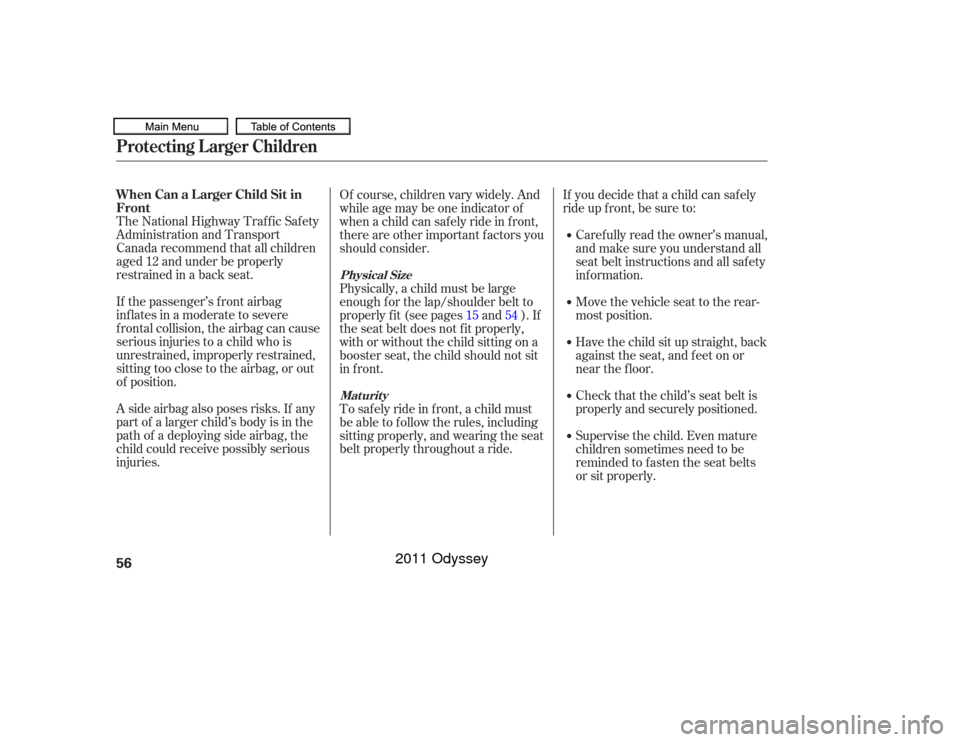
The National Highway Traffic Safety
Administration and Transport
Canada recommend that all children
aged 12 and under be properly
restrained in a back seat.
If the passenger’s front airbag
inf lates in a moderate to severe
f rontal collision, the airbag can cause
serious injuries to a child who is
unrestrained, improperly restrained,
sitting too close to the airbag, or out
of position.
A side airbag also poses risks. If any
part of a larger child’s body is in the
path of a deploying side airbag, the
child could receive possibly serious
injuries.Of course, children vary widely. And
while age may be one indicator of
when a child can saf ely ride in f ront,
there are other important f actors you
should consider.
Physically, a child must be large
enough f or the lap/shoulder belt to
properly f it (see pages and ). If
the seat belt does not f it properly,
with or without the child sitting on a
booster seat, the child should not sit
in f ront.
To saf ely ride in f ront, a child must
be able to f ollow the rules, including
sitting properly, and wearing the seat
belt properly throughout a ride.
If you decide that a child can saf ely
ride up f ront, be sure to:
Caref ully read the owner’s manual,
and make sure you understand all
seat belt instructions and all saf ety
inf ormation.
Move the vehicle seat to the rear-
most position.
Have the child sit up straight, back
against the seat, and feet on or
near the f loor.
Check that the child’s seat belt is
properly and securely positioned.
Supervise the child. Even mature
children sometimes need to be
reminded to f asten the seat belts
or sit properly.
15 54Protecting L arger ChildrenWhen Can a L arger Child Sit in
Front
Physical Size
Maturity
56
10/07/17 09:41:49 31TK8600_061
2011 Odyssey
Page 60 of 722
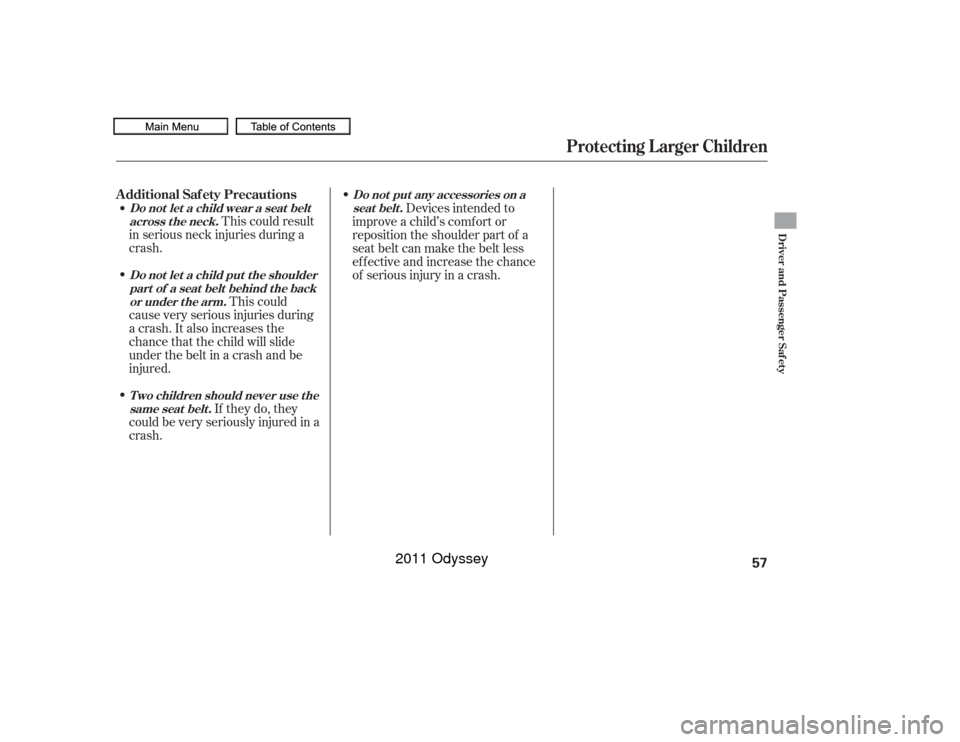
This could result
in serious neck injuries during a
crash.
This could
cause very serious injuries during
a crash. It also increases the
chance that the child will slide
under the belt in a crash and be
injured.
If they do, they
could be very seriously injured in a
crash. Devices intended to
improve a child’s comf ort or
reposition the shoulder part of a
seat belt can make the belt less
ef f ective and increase the chance
of serious injury in a crash.
Protecting L arger Children
Additional Saf ety Precautions
Do not let a child wear a seat belt
across t he neck.
Do not let a child put the shoulderpart of a seat belt behind t he backor under t he arm.
T wo children should never use t hesame seat belt . Do not put any accessories on a
seat belt.
Driver and Passenger Saf ety
57
10/07/17 09:41:54 31TK8600_062
2011 Odyssey
Page 64 of 722

This section gives inf ormation about
the controls and displays that
contribute to the daily operation of
your vehicle. All the essential
controls are within easy reach............................
Control Locations .62
............................
Instrument Panel .63
..........
Instrument Panel Indicators . 65
.............................................
Gauges .77
.............
Multi-Inf ormation Display . 83
Controls Near the Steering .........................................
Wheel .134 Windshield Wipers and
.................................
Washers .135
Rear Window Wiper and ...................................
Washer .136
.........
Turn Signal and Headlights . 136
.....................................
Fog Lights .139
......
Instrument Panel Brightness . 140
...............
Hazard Warning Button . 142
...............
Rear Window Def ogger . 142
......
Steering Wheel Adjustments . 143
.............................
Keys and Locks .144
......................
Immobilizer System .145
..............................
Ignition Switch .147
.....................
Remote Transmitter .148
Opening or Closing the Power .........................
Sliding Doors .151
Opening or Closing the Power ..................................
Tailgate .151
....................................
Door Locks .155
....................
Power Door Locks . 155
Auto Door Locking/ ..............................
Unlocking .156
............
Childproof Door Locks . 162
..........................................
Tailgate .162
..........................
Power Tailgate .163
.................................
Sliding Doors .167 ...............................................
Seats .175
..................................
Seat Heaters .189
Driving Position Memory ........................................
System .190
............................
Power Windows .192
.......................................
Moonroof .195
...........................................
Mirrors .197
...............................
Parking Brake .199
.........
Interior Convenience Items . 201
.....
Removable Center Console . 202
............
Flip-up Trash Bag Ring . 203
.....................
Beverage Holders .203
..............
Integrated Sunshades . 205
....................
Sunglasses Holder .206
................
Conversation Mirror . 207
...................................
Sun Visor .207
............................
Vanity Mirror .208
................................
Coat Hooks .208
..................................
Glove Box .208
...........................
Center Pocket .209
....................................
C ool Box
.209
....................................
Coin Box .211
........
Accessory Power Sockets . 211
.......................
AC Power Outlet .212
...............................
Interior Lights .213
Instruments and Controls
Instruments and Controls
61
10/07/17 09:42:28 31TK8600_066
2011 Odyssey
Page 165 of 722
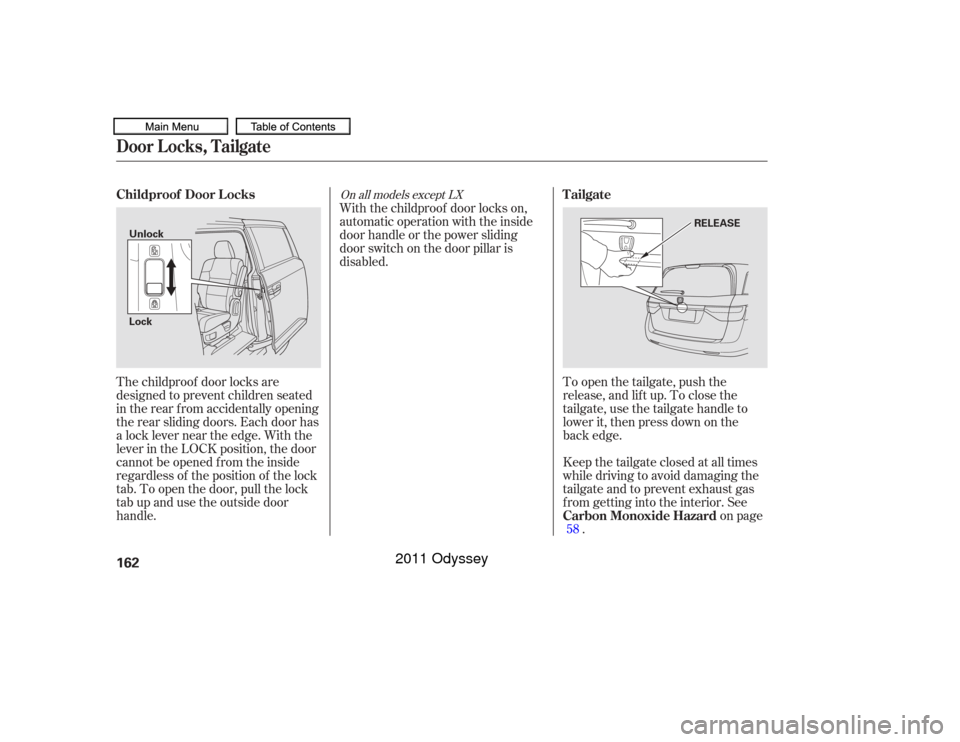
The childproof door locks are
designed to prevent children seated
in the rear f rom accidentally opening
the rear sliding doors. Each door has
a lock lever near the edge. With the
lever in the LOCK position, the door
cannot be opened f rom the inside
regardless of the position of the lock
tab. To open the door, pull the lock
tab up and use the outside door
handle.With the childproof door locks on,
automatic operation with the inside
door handle or the power sliding
door switch on the door pillar is
disabled.
Keep the tailgate closed at all times
while driving to avoid damaging the
tailgate and to prevent exhaust gas
f rom getting into the interior. Seeon page
.
To open the tailgate, push the
release, and lif t up. To close the
tailgate, use the tailgate handle to
lower it, then press down on the
back edge.
58
On all models except LX
Childproof Door L ocks T ailgate
Carbon Monoxide HazardDoor L ocks, T ailgat e162
Unlock
Lock RELEASE
10/07/17 09:55:39 31TK8600_167
2011 Odyssey
Page 187 of 722
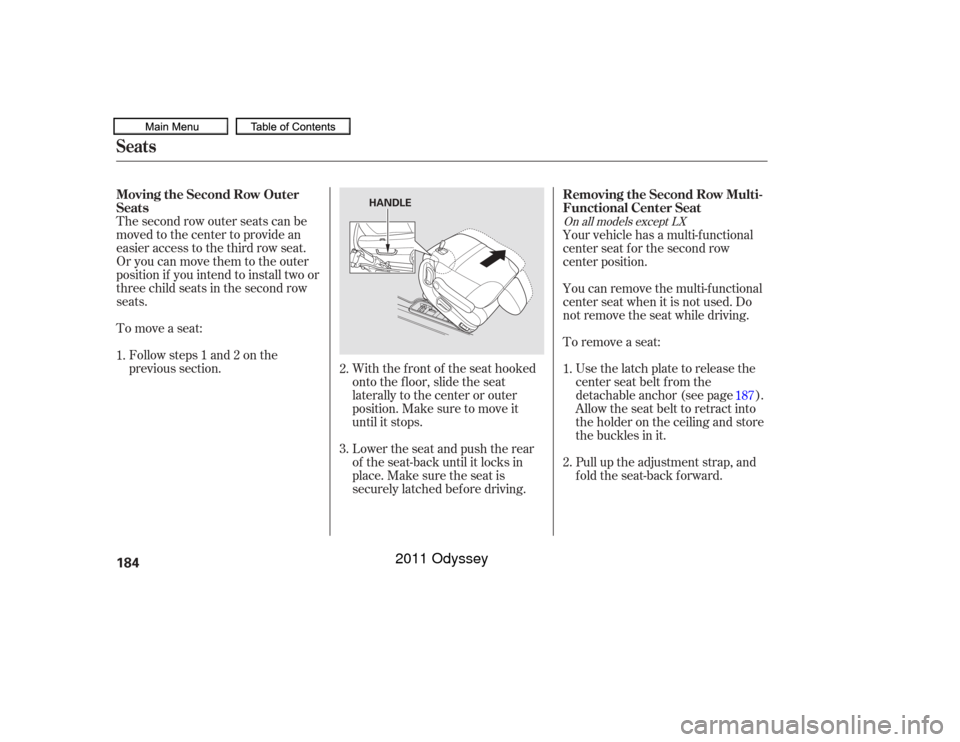
On all models except LX
The second row outer seats can be
moved to the center to provide an
easier access to the third row seat.
Or you can move them to the outer
position if you intend to install two or
three child seats in the second row
seats.
To move a seat:Followsteps1and2onthe
previous section. With the f ront of the seat hooked
onto the f loor, slide the seat
laterally to the center or outer
position. Make sure to move it
until it stops.
Lower the seat and push the rear
of the seat-back until it locks in
place. Make sure the seat is
securely latched bef ore driving.Your vehicle has a multi-f unctional
center seat f or the second row
center position.
You can remove the multi-functional
center seat when it is not used. Do
not remove the seat while driving.
To remove a seat:
Use the latch plate to release the
center seat belt f rom the
detachable anchor (see page ).
Allow the seat belt to retract into
the holder on the ceiling and store
the buckles in it.
Pull up the adjustment strap, and
fold the seat-back forward.
1.
2.
2.
3. 1.
187SeatsMoving the Second Row Outer
Seats Removing the Second Row Multi-
Functional Center Seat184
HANDLE
10/07/17 09:58:57 31TK8600_189
2011 Odyssey